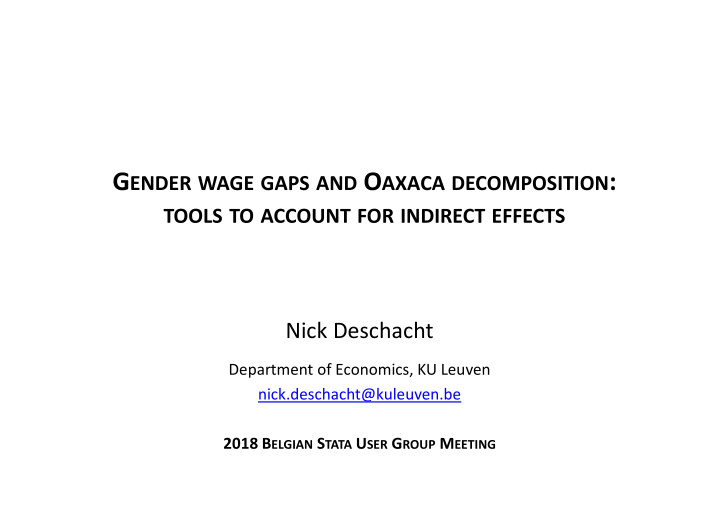



G ENDER WAGE GAPS AND O AXACA DECOMPOSITION : TOOLS TO ACCOUNT FOR INDIRECT EFFECTS Nick Deschacht Department of Economics, KU Leuven nick.deschacht@kuleuven.be 2018 B ELGIAN S TATA U SER G ROUP M EETING
1. Introduction • The command meddecomp carries out a mediator decomposition, i.e. a Oaxaca decomposition in the presence of mediation effects. • Oaxaca decomposition is often used to estimate to what extent gender differences in characteristics can explain the gender wage gap. In the example: – 327€ (45%) of the overall wage gap of 728€ can be explained by gender differences in characteristics. – 26% can be explained by the fact that men work more hours per week and 4% by the fact that men are more committed. – The sum of the contributions in the detailed decomposition equals the total explained part (45%). 2
2. a) Oaxaca decomposition The simple case of one explanatory variable: Male mean wage Explained part Female counterfactual mean wage Unexplained part (‘discrimination residual’) Female mean wage 3
2. a) Oaxaca decomposition The contribution of a variable � to the gender wage gap is: • � � − � � � . � ∗ � where � ∗ is the estimated effect of � on wages. E.g. if men have 20 years of experience, women only 18 years and � ∗ is 20 euro per year, then the part of the gender wage gap explained by the gender difference in experience is (20-18).20 = 40 euro. � ∗ can be estimated using the male sample only, the female sample or by • pooling men and women. The choice depends on theoretical assumptions regarding discrimination, but pooling has the advantage that the coefficients are estimated using a larger sample (Neumark 1988). • In Stata this decomposition can be done via the user-written command oaxaca (Jann, 2008). Extensions for nonlinear decomposition have been proposed by Yun (2005, built into oaxaca ), Fairlie ( fairlie : Jann, 2006) and Bartus ( gdecomp ). 4
2. b) Mediation effects The effect of a variable � � on � depends on the assumed underlying • causal model. In the standard model, the effect of � � is the effect holding the other explanatory variables constant. The mediator model The standard model d � � � � � � a b � � � � In the mediator model, the total effect of � � is the sum of a direct effect • ( d ) and an indirect effect ( a.b ) through an intermediate variable (the mediator). E.g. Catherine Hakim (2002) argues that preferences are more important than is often assumed because preferences not only affect wages directly, but also indirectly via working hours (part-time work). • Stata estimates mediator effects via the commands sem and gsem . 5
3. The meddecomp command • The command essentially performs a Oaxaca decomposition using the total effects (direct + indirect) obtained through a sem model. – by specifies the groups. – med specifies the mediator and the variable(s) that affect the mediator. • meddecomp relies on the oaxaca command (Jann, 2008) for point estimations, standard errors and presentation of results. • Example in Stata: 6
3. The meddecomp command Compared to the standard model, the mediator decomposition results in the same overall decomposition (the total explained part is the same) but the detailed decomposition (the contribution of each explanatory variable) is adjusted to account for the indirect effects. 7
4. Command options and limitations • meddecomp allows the aggregation of subsets of variables as in the oaxaca command. • Categorical variables can be included using the prefix xi . Factor variables are not allowed because meddecomp relies on oaxaca and sem. • Example in Stata: 8
4. Command options and limitations • The default decomposition uses the coefficients from a pooled model to which groupvar is added. Excluding groupvar ( omega ) is optional. The use of either male or female coefficients is not possible in this version. • adjust allows the mediator decomposition to be done using oaxaca by adding the options ref(meddecomp) x1($adjust) . Example in Stata: results without standard errors (option nose ) • meddecomp only allows one mediator and no more complex pathways than the simple mediator causal model. 9
Recommend
More recommend